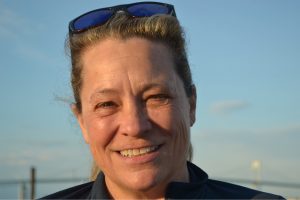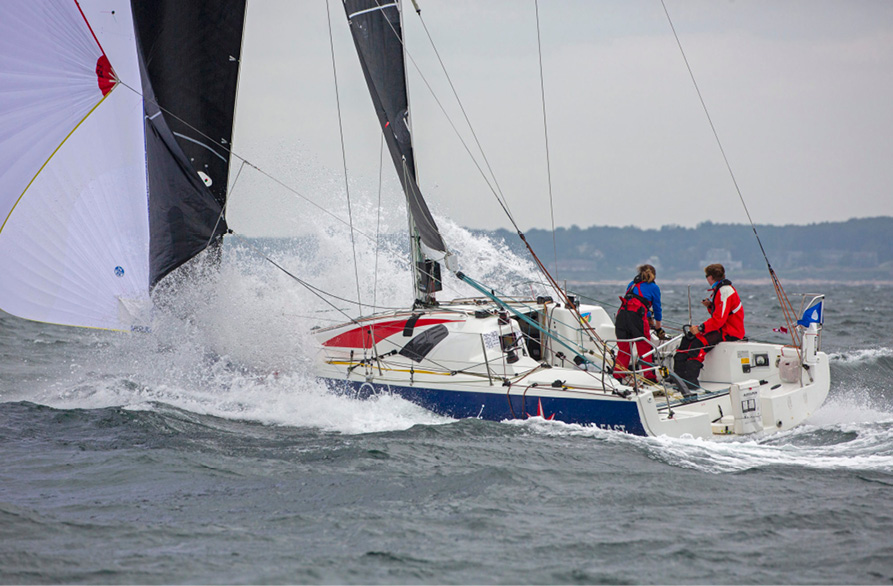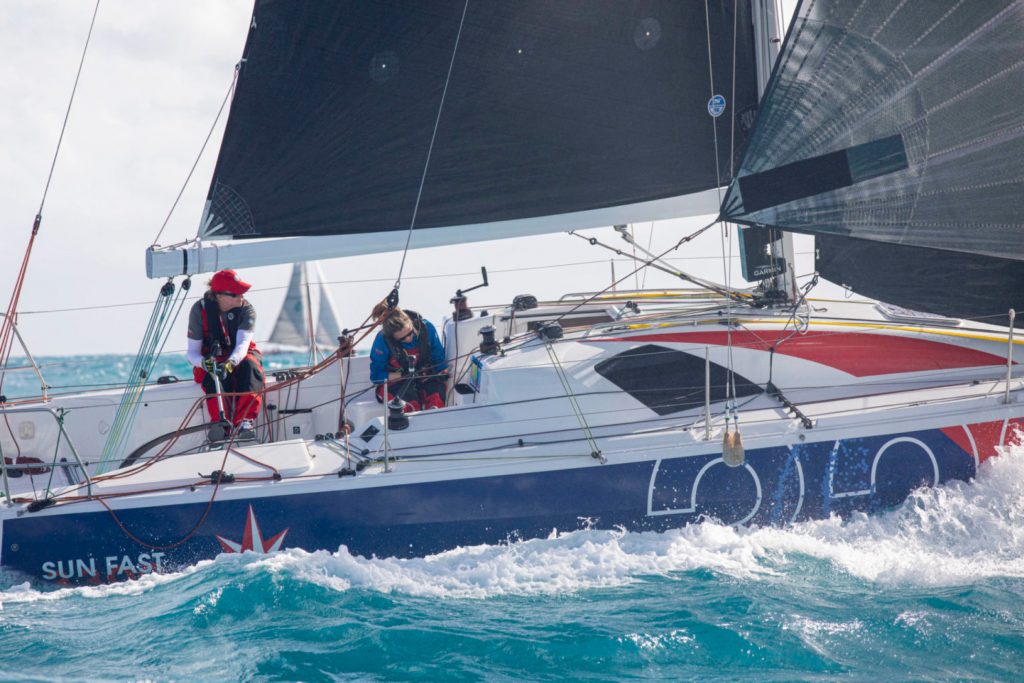Interview by Joe Cooper

Suzy Leech © joecoopersailing.com
What is the gag about “How do you get to Carnegie Hall?” I caught up with another new Newport Local, Suzy Leech, the self-described bow chick on that legendary Mighty Mary, for a coffee at Belle’s in Newport recently. In addition to the America’s Cup (albeit defeated in the Defender Finals) Suzy’s CV includes a cruise around the world (well, half of it) with the family as a Padawan Learner; an Olympic campaign with Betsy Alison; globally ranked in the Women’s International Match Racing circuit; national and world championships, with other women and with the blokes. Oh, and a degree in Fluid Dynamics and working with NASA.
Coop: Was sailing “a thing” in your family?
Suzy Leech: Oh, yes. My Dad was captain of the U.S. Naval Academy Sailing Team, and crewed on the first U.S. boat to win the Admiral’s Cup, in 1969. We were members of American Yacht Club in Rye, New York, and Mom did deliveries and sailed with Dad on the Etchells and other boats on Long Island Sound. So really, I never had a hope.
Coop: What are your earliest memories on being on a boat?
SL: My earliest memory, let’s say I was about three or four, is hanging onto the inside edge of the deck on the Etchells, standing on something in the cockpit and looking out across the deck at the water. We had moved to Annapolis in 1971. Dad worked for IBM (and sailed with Tom Watson), and he was transferred from White Plains to Washington.

Suzy and co-skipper Ken Read send it aboard their Jeanneau Sun Fast 3300 Alchemist on a blustery Narragansett Bay. © Billy Black/billyblack.com
Coop: Did you do much sailing in Annapolis?
SL: Oh, not much, just the family dinghy at that time. Dad had sold the Etchells by then, but we did all fly to Bermuda to meet him after the Newport Bermuda Race every other year. In 1977 I sailed on Tempest, an S&S 81-footer, in the Annapolis to Newport Race. It was a very light air race: we could build card houses on the settee table. I made mayonnaise sandwiches for the crew at Oh-Dark-Hundred, coffee, and so on.
Coop: OK, tell me about this cruise around the world.
SL: Mom, Dad, me, my older sister Liz and brother Spencer set off from Annapolis in 1977 for a family circumnavigation. That was great: down the coast, across the Caribbean, through the Panama Canal to the Galapagos and Marquesas, and all across the South Pacific to American Samoa.
Coop: What was the boat?
SL: A John Alden-designed Offshore 50; a hefty but fast cruising boat.
Coop: And you were what age?
SL: Around 10.
Coop: American Samoa is only halfway…?
SL: Well, I cannot remember all the finer details, but Dad was working for the U.S./Samoan government, and the locals out there were getting restless. It was decided that we should get out of there, so we came back to Annapolis and moved in with my Granny. She was a hoot. Before we left on the trip, we were living the idyllic kids’ life, swimming, splashing in the mud and Granny would feed us all the local seafood, crab done fifteen different ways, and so on.
Coop: Annapolis…Well, I guess you were able to continue sailing there?
SL: Ha, yes. I was the kid roaming the docks asking if anyone needed crew.
Coop: How did that work out?
SL: Well, you keep at a thing and eventually it works out just fine. I got rides on all sorts of boats with all sorts of characters. I got to the point where I would call the local North Sails loft and ask who was looking for crew that afternoon or weekend, and beat feet to where that boat was kept.

With North Sails and Jeanneau America teaming up to promote doublehanded sailing, Suzy and Kenny raced Alchemist to victory in the new Doublehanded Class in the 45th edition of the Fort Lauderdale to Key West Race. © Billy Black/billyblack.com
Coop: Some serious on-the-job education, eh?
SL: Yes, but if you pay attention, do your job, learn it, get better at and be a good shipmate, people want to sail with you…or rather at that time, you to sail with them. I sailed, doing the bow, with Mort Weintraub on Troubadour at Block Island Race Week in oh, 1992.
Coop: We must be getting close to the Aerospace part of the evening. How did this end up being the answer to the question, “What am I going to do (at college)?”
SL: Well, I really wanted to be an architect. I carried a graph paper book and was always looking at, and drawing houses, figuring out the interiors, what it should look like…you know, architect stuff.
Coop: But…
SL: I had heard that the Architecture school at UVA was really tough to get into. I was interested in Engineering, but not Civil, building bridges, nor Electrical Engineering, though the irony is, that would have been perfect for what I am interested in and doing now. Certainly not Nuclear: Waaayyy too hard. So, Aerospace it was.
Coop: Have you ever worked in that field?
SL: Yes. After graduating and working as a waitress for that summer, I went to work for NASA in the Microgravity Division connected with the Space Station. I worked there from 1988 to the spring of 1994, before going to San Diego.
Coop: For the America’s Cup?
SL: Yes.
Coop: OK, so how did you get involved in Mighty Mary?
SL: I had met Dawn Riley the previous year at the Governor’s Cup, and of course during the course of that regatta we would be talking, ending with Dawn telling me to send my resumé to her. I did of course, and I went out to San Diego to try out in April 1994. From more than 800 resumés submitted, a total of 60 aspirants were invited to try out, from which a team of 28 was selected, including me. I went back in June of 1994 for a year of full-time sailing.
Coop: You ended up doing the bow. How does a not-so-big person like you come to grips with that highly visible position?
SL: Well, I figured that none of us (girls) had sailed on anything like this and I thought that trying to learn on the water would take just too long, so I came up with a plan for what amounts to a playbook. A friend gave me 40-plus hours of VHS tapes from the 1992 series and I studied them, eventually editing them into clips for each particular maneuver.
Coop: Was Mighty Mary “modified” to make her easier for a less strong crew to sail?
SL: No, we just got stronger and used more people for any activity. We put handles on the kite pole and relatively simple things that would allow a fit, pretty strong person, male or female, to handle the gear. I think the winch pedestals might have been a custom detail, slightly shorter than normal.
We had a lot of input into the boat’s layout, and it worked for the crew we had.
Coop: What was the feeling when Dave Dellenbaugh was brought aboard?
SL: Ah, that ran the gamut from “No Never!” to “We are here to win.” The no-never side rejected the idea of having a guy on the boat: “That is not what we are here for.” Other sailors were willing to do whatever was necessary. Dave had the experience we lacked, so the management decided to bring him onboard.
Coop: And there have been very few women on the sailing side of the AC since…
SL: Other than two co-ed teams run by Dawn Riley in the 2000s, women have not had sailing roles in the Cup. There are a few reasons for this, but the world is hopefully changing. Opportunities at the lower end of sailing for women to get into programs where the skills – and frankly the contacts – can develop are still lean, compared to the guys. We all need to help give a leg up, and build from the bottom up – creating opportunities for the next generation of female sailors.
Coop: Advice for young female sailors?
SL: Ask around. Get on boats. Make contacts. Show up before boat call. Do your job, listen, pay attention on the boat, and then contribute!
Coop: What are you up to these days?
SL: Still sailing, everything from a recently sold J/70 to 50-meter Perini Navis around the globe, and now getting into foiling. Also sailing doublehanded with Kenny Read, which is fun, new and different for me!
Developing apps for sailing; something the average beer can sailor can use, right on their phone. One app is in fact called Beer Can Racing. You can enter marks, TWD and start/finish lines, and it gives you the course layout on your phone or iPad. Mainly tools that give information for the way I like to sail.
Coop: Thank you Suzy! See you on the water.




